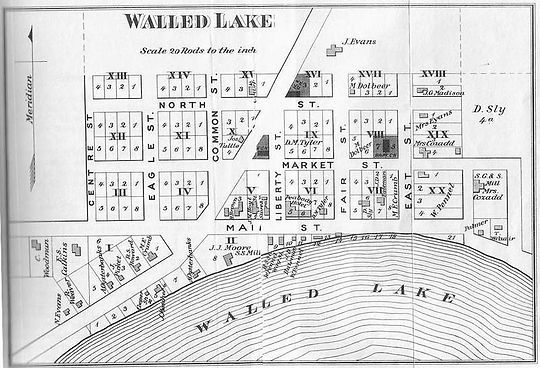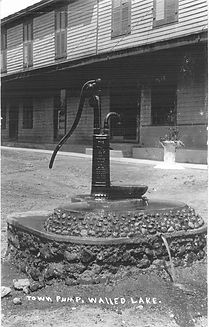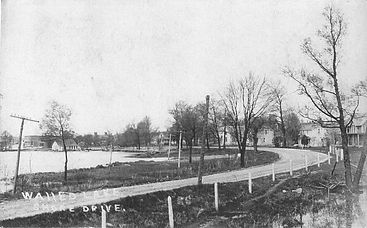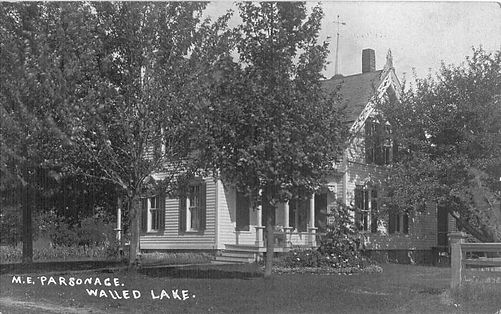
Walled Lake History
Village Life

The first two settlers of Commerce Township, both originally from New York, arrived just one month apart. Abram Walrod settled in May 1825, followed by Walter Hewitt in June of the same year. Walrod is credited with building the township's first log house, though he left for the western side of Michigan about five years later. His settlement was in section 10 of Commerce Township, far from the original village. As a result, Walter Hewitt is considered the first settler of the village itself and the first to construct a log house there. Following Hewitt’s arrival, the village began to grow steadily, expanding slightly eastward along the lakeshore from his original settlement.
Early village life was not much different than most pre-settlement societies. It was difficult to obtain goods and most would live self-sufficiently on their own produce and livestock. For essential goods, settlers would need to make an 11-mile journey to Oakland County’s seat, Pontiac. Here they could source goods like groceries and flour and received services at sawmills and blacksmith shops. However, before long, they could obtain flour closer to home from mills in Farmington and Northville. Many followed in Walter Hewitt’s footsteps, establishing their homes along the west side of the lakeshore. Among the early settlers, William Tenney built his log home (1833), William Jarvis established the first log inn and tavern in 1830, and William R. Adams opened the first log grocery store in 1833. This area also became home to the village’s first cemetery, church, and school.
The year 1833 marked a turning point in the village's development, as it saw the arrival of many skilled settlers who played a crucial role in shaping its growth. It was during this time that the first stone mason, Freeborn Henry Banks*, arrived, along with the first cooper, William Hooley Banks*. Randall Colvin, the village’s first carpenter, also settled in alongside the first blacksmith, known only as Godfrey. These individuals were instrumental in laying the foundation for the village’s early infrastructure and craftsmanship.
Travel to the village became more accessible with the construction of highways connecting Pontiac to Ann Arbor, surveyed by Hervey Park between 1834 and 1835. In 1836, Jesse Tuttle, a highly influential figure in the village, officially platted the land, streamlining the process of land purchases.
Traveling from the original settlement east toward the village were the homes of Roswell Weaver, R.S. Howard, John Picket, and the Tuttle family, lining the side of Pontiac Rd opposite the lakeshore.* John Picket, a skilled cooper, owned a home of notable quality, regarded as one of the finest in the village. His cooperage shop, located across the road on the lakeshore, was part of a profitable trade that involved crafting barrels, pails, buckets, and washtubs.
Pontiac Road curtailed along the northwestern shore and intersected with Main Street, which ran through the heart of the village. In 1834, Thorne Deuel built a dry goods store on the lakeshore side at this intersection. Not long after, Deuel sold the store to Benjamin Brown, who relocated it across the road at the corner of Main and Pontiac, opposite the shoreline. Here, Brown continued his trade, and according to Justice Joseph B. Moore, “Mr. Brown had one of the finest, if not the finest, country stores in Oakland County.” William Tenney, a Baptist deacon and the village's first postmaster, operated the first post office from Brown’s store. It was also rumored that Benjamin Brown occasionally practiced dentistry for the villagers—despite lacking a proper license!
In May of 1840, the village welcomed its first doctor, Dr. James M. Hoyt from New York. In addition to his medical practice, Dr. Hoyt was also a merchant, building a store just east of the Thorne/Brown store. Eventually, the post office was relocated to Hoyt's business, with Roswell Weaver serving as the second postmaster. Dr. Hoyt’s home, situated just north of his store, was considered a remarkable residence for its time.





Town Pump at the corner of Main and Liberty Street
Hauling lumber by horse and sled across the frozen lake
Before 1840, lumber used to construct the village was sourced from Farmington and Pontiac, brought in by ox teams. However, in 1840, a key figure named Harmon Pettibone established a lumberyard and constructed a large frame building on Main Street just east of Liberty Street. Built using lumber from his own yard, this structure became the village's second inn, known as the Pioneer Inn. In 1872, the inn was sold to C. Peabody and subsequently renamed the Peabody House. The Peabody House featured a ballroom, hosted numerous tourists, and was known for its regular hypnotist performances. It was also occasionally used for public trials. In later years, the east end of the Peabody House became a salesroom for Ford automobiles. Pettibone's lumberyard was eventually sold to another prominent figure, Jacob Jonathan Moore, in 1858, who renamed it Moore’s Sawmill.
A major focal point of the village was located at the intersection of Main and Liberty. Here sat the town pump, a historic marker that would quench the thirst of the farmers, children, and animals. It was wooden and painted gray, perched on a platform 8 inches off the ground. The animals would feed from the surrounding washtub, while the villagers used a cup which was nailed to the adjacent post. The old pump required priming, one would need to pour water through the opening spout, pump the handle, and listen as it would creak and groan until the water would flow through.
Passing the Town Pump moving east on Main St is the home of one of the first stone and brick masons DM Tyler. Traveling further would find the homes of Daniel Sly and William Pennell, one of the first carpenters and first blacksmiths. In this area there was the Cobbler shop, the butcher, and the flour grist mill. North of this area was Jacob Mascho’s home, situated across Market Street.
An intriguing winter activity, described in The Story of a Village Community, was known as "getting up ice." Before refrigeration and the establishment of the village ice plant, storing perishable items was a challenge. Villagers would cut large blocks of ice from the lake using hefty saws, with some blocks measuring as much as 2 feet by 3 feet. These ice blocks were then stored in cool areas of homes and barns, insulated with sawdust, to preserve them for use during the hot summer months.
John Severance was the village cobbler during this time, with his shop located just east of Pennell’s blacksmith shop, proudly displaying a sign in the window that read, "John Severance, Boots and Shoes." Despite having a limp due to one leg being shorter than the other, he was well-regarded for crafting high-quality shoes, snowshoes, and performing expert repairs. His brother, Charles Lamb Severance, established the town’s first meat market in 1876, a small building on the lakeshore just east of the village, which featured an underground cellar for storing meats. Charles ran the business alongside his son, Arthur Severance, who also operated the slaughterhouse north of the village near the muck swamp.
East of the meat market stood the grist flour mill operated by the Cozad family, which kept the village well-supplied for many years. However, as more efficient water-powered mills emerged in Pontiac and Northville, the Cozad mill was eventually abandoned and repurposed for grain storage.
William Pennell’s blacksmith shop was located on the lakefront, next to the village hardware store, near what are now Eddy’s and the Tiki Bar. North of this, across Main Street, stood Hoyt’s store, which was operated by the Gage family, and behind it on Liberty Street was Dr. Hoyt’s pharmacy. The pharmacy, a modest 15x20-foot shop with a square front extending to the roof ridge, was where Dr. Hoyt prepared his own medicines. Due to the high cost and difficulty of obtaining brand-name medications, he created affordable remedies for the villagers. In the mid-1800s, it took twelve days for news to travel from Washington to Oakland County, and shipments of goods were equally slow. Dr. Hoyt’s shelves were lined with bottles of various sizes, all uniformly white with black labels. These labels displayed the Latin names of his homemade remedies, such as aconitina, nux vomica, pulsatilla, rheum. rhap., bryonia, digitalis, and ipecacuanha—herbs and compounds used to treat common illnesses of the time.
Grocery Stores
William R. Adams built the first grocery store in the village, a modest log structure on a hill near the cemetery on the western shore. His store sold dry goods, Yankee notions (American-made products), and most famously, whiskey, which Adams is said to have distilled himself. According to local lore, the whiskey was flavored with the “beautiful blue water” of Walled Lake.
The next grocery store was constructed by Thorne Deuel, located at the corner of Main Street and Pontiac Road along the lakeshore. Not long after, Benjamin Brown purchased the store from Deuel and rebuilt it opposite the lakeshore, still at the same intersection. Brown operated the store for many years, and it was regarded as one of the finest in Oakland County. Over the years, the building changed ownership, passing from Benjamin Brown to James L. Humphrey and eventually to the Parmenter family. Today, the historic building remains in downtown Walled Lake and is known as the successful Green House.
East of this store stood another building owned by Dr. James M. Hoyt, which he leased to various village entrepreneurs. This space housed a general store, co-owned by R. Smith Howard* and David Gage. Prior to this, David Gage operated a grocery store with his son, Stephen M. Gage, across from the Peabody House on the lakefront.
Gage’s store was large for its time, measuring around 40x60 feet. Due to the natural slope of the land north of the lake, the back of the store was at ground level, while the front was elevated about four feet, requiring 6-8 steps to reach the entrance. H.O. Severance once noted that a horse and buggy could be pulled right up to the front, where the store's floor was level with the buggy. At various times, the store was clerked by David Gage, Stephen M. Gage, and R.S. Howard, and it carried "everything a villager might want."
Upon entering, visitors would see the post office to the right, managed by postmaster Roswell Weaver. Beyond the post office was a 15-foot-long counter stacked with scales, sacks of flour, and cornmeal. The shelves were stocked with spices, extracts, canned goods, tobacco, and everyday groceries such as coffee and salt fish. Behind the storekeeper’s counter were barrels filled with sugar, crackers, and salt. In the back, one could find New Orleans molasses, maple syrup, vinegar, and kerosene. Scattered throughout the store were toiletries, thread, calicoes, bolts of fabric, handkerchiefs, and clothing like flannels, socks, mittens, gloves, and straw hats. Villagers could even purchase household items like tubs, washboards, kettles, and pans. At the center of the store was a wood stove, surrounded by chairs where villagers gathered to share gossip and news.
Churches
It was common for missionaries to follow pioneers as they moved westward, eager to spread their faith in the newly established territories. In Oakland County, Caleb Lamb and his brother, Nehemiah Lamb, are recognized as pioneering missionaries for the Walled Lake area. They introduced the Baptist faith to the community, with Reverend Caleb Lamb leading the first public religious service.
The First Baptist Church of Walled Lake was established in February 1834 in the original log schoolhouse on the Moore farm, the site of the present-day Walled Lake Cemetery. Reverend Noyes* officiated, and the founding members included Deacon William Tenney, Matthew Heber Hungerford, and Randall Colvin.
When the log schoolhouse burned down in 1836, Jabez Brown, one of the founding members, hosted church services in his home. By the spring of 1837, the community built its first dedicated religious structure at the same location, the now present-day Walled Lake Cemetery. This modest frame building, measuring 28 by 40 feet and capable of accommodating up to 300 people, was constructed at a cost of $500, funded by the local congregation.
That same year, the church society was formed and included prominent members such as Dr. JM Hoyt, the Severance family, Hiram Jones, RS Howard, and DM Tyler. The Sabbath school also started and was run by Joseph Donaldson.
The Methodist Episcopal Church of Walled Lake became the village's second religious society, beginning its services in the schoolhouse in 1838 under the leadership of William Noe. The congregation was served by preachers Dr. Reverend Hayes and Reverend Oscar North. The Methodists continued to hold services in the schoolhouse until the spring of 1858, when they acquired the Odd Fellows Hall at the corner of North Street and Pontiac Road. The community enthusiastically transformed the building into both a church and parsonage. In 1875, the Methodists constructed a larger church at the intersection of North and Fair Streets. The new building, measuring 36 by 60 feet, accommodated up to 200 villagers and was built at a cost of $5,000.
Schools
The village's first non-residential log building was its original schoolhouse, constructed by the early settlers using locally sourced logs. The roof, made of oak shakes, was crafted by Lyman Hathorn. As previously stated, this rustic structure was located on the Moore farm, which is now the site of the Walled Lake Cemetery. Inside, the desks were fashioned from logs fitted with pegs, and the pens were made from goose or turkey buzzard quills.
In 1836, the first schoolhouse burned down and was replaced with a larger, more robust structure in the heart of town. Located about 40 rods (660 feet) north of the town pump and just north of J.M. Hoyt’s pharmacy on Liberty Street, the new school measured 30 by 49 feet and was primarily built from stone. Large rocks were broken down, shaped with stone hammers, and laid in quick lime and mortar. Remarkably, this building still stands today in Walled Lake and is known as Stonecrest.
Classes were held five days a week, from fall to spring, giving students time to help on family farms during the summer. The school day included two 15-minute recesses and a one-hour break for lunch. Younger students would spend much of the day reciting the alphabet and multiplication tables from memory. School life was strict and somewhat austere, with little storytelling or social interaction allowed. Any misbehavior was met with punishment, often involving a "ferule of the hand," which by today’s standards would likely be considered abusive. Popular recess games included Duck on the Rock, Horseshoes, One Old Cat, and Pom-Pull-Away.
Female teachers earned a monthly salary of $6, while their male counterparts received between $12 and $16 per month. Notable educators, in addition to Fanny Tuttle, included Justice Joseph B. Moore and Sadie E. Bicking. Teaching at the time placed a strong emphasis on spelling, as there was no standardized education system in the Michigan Territory. A popular activity, similar to today’s spelling bees, was called “Spelling Down.” Riley Keith, both a student and later a teacher at Stonecrest, was renowned for his skill in this competition, earning the reputation as the best "Spell Down" participant in the county and winning several prizes.
Stonecrest earned a reputation as the best school in the county and maintained that standing for many years. However, the one-room building could no longer accommodate the growing community. In 1895, the school board constructed the Standard School in the western part of the village, doubling the size to include two rooms and two teachers. One room served grades 1 through 4, while the other housed grades 5 through 8. Eventually, this building was sold to the Masonic Order.
In 1922, the Walled Lake Consolidated School, a grand brick structure with 15 classrooms, was built along Pontiac Road, just north of the village. Students were thrilled with the new building and celebrated its opening by marching the mile from the Standard School, proudly carrying American flags. This was the first consolidated school in Oakland County, serving grades 1 through 12 and enrolling just under 200 students. The school was an impressive three-level, two-and-a-half-story building. A large stone in front commemorated the event, engraved with the names of the architect, Byron K. Mills, the builder, Wesson Company, and the first school officials. Inside the stone was a time capsule filled with items from the era. In the building's grand entranceway, a swastika could be seen painted on the wall, a Native American symbol of good fortune, reflecting the cultural interpretation of the time.


Further Development
In 1871, Willard Clark Wixom, son of early settler Ahijah Wixom, granted early railroad companies permission to build on his property. By 1883, the Michigan Air Line of the Grand Trunk Railway system, which ran from Pontiac to Jackson, passed through Commerce Township and established a crucial railroad junction. At this pivotal intersection, Willard Wixom, along with Judson L. Sibley, son of another notable early settler, Alonzo Sibley, constructed a union depot and mail station. Known as Wixom Station, located just half a mile from Walled Lake village, this stop became a crucial hub for the transportation of goods and passengers, making it a major shipping point for the region.
The Grand Trunk Railway system in Walled Lake, the opening of the Eastern Michigan Asylum for the Insane in Pontiac, and the efforts of storeowner Stephen Gage were instrumental in helping the local farmers and villagers weather the Great Panic of 1873. This financial crisis, which preceded the Great Depression of the 1920s, affected both the New and Old Worlds. It was triggered by the rapid expansion of agriculture, manufacturing, and railroads, which caused a significant drop in product prices. Other contributing international factors included speculative land investments, the devaluation of silver, and economic disruptions following the Franco-Prussian War.
Recognizing that the growing population of Walled Lake was still too small to fully support local farmers, Stephen Gage expanded his market beyond the village. He began delivering produce to less densely populated areas, ensuring a wider customer base. The Grand Trunk Railway system further enabled farmers to sell their goods to travelers passing through from Pontiac to Jackson, while the Eastern Michigan Asylum for the Insane became a massive consumer, purchasing produce to feed both its inmates and staff.
By the 1870’s, the population was nearly 400 boasting around 40 families. The village had a general store, post office, steam grist mill, cider factory, cooper factory, several blacksmiths, a Baptist church, a Methodist Episcopal church, two doctors, and a handful of attorneys. At the time of H.O. Severances writing (~1920’s), the village had around 1,000 cottages within a half mile radius of the lake. It also had a roller coaster, a successful ice plant, two hotels, a handful of chain stores, two restaurants, ice cream parlors, meat markets, grocery stores, a drug store, a bank, barber shops, hardware stores, the Walled Lake Fur Company, The Commodious Brick Building for the consolidated school, and the developing Pierce subdivision.
Notes:
*US General Land Office Records data shows that many plats of land in Commerce Township (Township No.2, Range 08E) were bought prior to being platted in 1836 by Jesse Tuttle. It is unknown if this land was platted by someone else prior to 1836 or if Tuttle platted the land prior to 1836, but the discrepancy exists.
*HO Severance states that the name is WT Banks, however further research proves the name was likely William Hooley Banks.
*HO Severance states that the name is FH Brooks, however further research proves the name was likely Freeborn Henry Banks.
*Reverend Noyes was potentially Robert E. Noe or William Noe, as they were prominent members and reverends of the Methodist Episcopal Church.
References:
1. Severance, Henry Ormal. The Story of a Village Community. G. E. Stechert & Co, 1931.
2. Durant, Samuel W. History of Oakland County, Michigan. L. H. Everts & Co, 1877.
3. “Panic of 1873.” Wikipedia, Wikimedia Foundation, 28 Sept. 2024, en.wikipedia.org/wiki/Panic_of_1873.
4. “Wixom Historical Society.” Wixom Historical Society Wixom History Comments, www.wixomhistoricalsociety.org/wixom-history/. Accessed 6 Oct. 2024.
